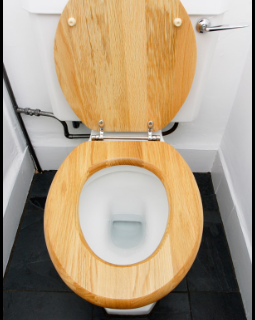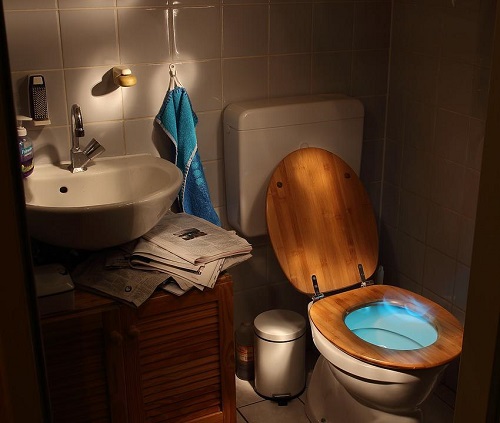Many people generally reach out for some kind of disinfecting product when cleaning toilets. Unfortunately, many of these commercial cleaners contain bleach. So, can you clean a wooden toilet seat in a similar manner to porcelain or plastic seats? The simple answer is NO! Wood is porous, and you must act with extra care when cleaning it. Moreover, wooden toilet seats can absorb bacteria, meaning the bacteria is not just on the surface. And that begs the question, are wooden toilet seats hard to clean? What is the best way to clean a wooden toilet seat?
Best Ways to Clean Wooden Toilet Seats
Being porous means that wood needs to be cleaned often, but it is somewhat delicate. Bleach can damage wood by lightening and streaking it, making it look ugly. Using something like scouring powder to clean your sink or bathtub is great, but it’s not good for cleaning wood toilet seats.
When it comes to cleaning a wooden toilet seat, it’s best to use a mild detergent, such as dish soap. Use a soft cloth or sponge to clean the toilet seat and then rinse it. Some cleaning products are gentler than others for cleaning the toilet seat.
If you have a wood toilet seat, try using some of the cleaning products from the cleaning company Murphy (or similar). Murphy Oil Soap is not antibacterial, but many dish soaps are. If you like, you can even use rubbing alcohol (isopropyl alcohol) to clean the toilet seat.
If you have a wooden toilet seat, you don’t have to sacrifice a clean and disinfected surface. It just means using gentle products on the wood while still doing what they should: cleaning and disinfecting it.
The following cleaning products will effectively clean, disinfect, and protect your wood toilet seat:
1. Dish Soap
Using a mild detergent such as dish soap to clean wooden toilet seats is safe. Hot water and soapy water cleans up any water that is spilled or misshaped without using harsh chemicals that could damage the surface.
2. Hydrogen Peroxide Solution
H2O2 (hydrogen peroxide) has been used as a disinfectant for several years. It kills bacteria by destroying their cell walls. It also kills bacteria and fungi/mold by dehydrating their cells. Hydrogen peroxide can be used straight from the bottle (usually sold at a 3% solution) or mixed with water to make a diluted solution. Leave it on the wooden surface for a few minutes, then rinse it off with warm water and a dry cloth.
3. Murphy’s Oil Soap
Last but not least, if you use toilet seats made from wood, use a product that will preserve the wood from drying out over time. A product such as Murphy’s Oil Soap will help you clean them and protect them, but it won’t disinfect them (such as the H2O2 mentioned above).
Things to Avoid When Cleaning a Wood Toilet Seat
Here are a few things to avoid when cleaning wood toilet seats:
1. Bleach
Bleach will cause the wood to look white. It will not be noticeable right away, but the color of the wood will gradually lighten or discolor over time. Bleach can easily discolor wood surfaces by slowly stripping the protective layer on the wood, exposing the wood below, and speeding up the deterioration.
2. Vinegar
Although vinegar may seem like a more natural and gentle cleaning product for porcelain, it is not recommended on wood surfaces. Vinegar is an acid (acetic acid, to be accurate) that will ruin your wood surfaces and damage the protective coating on the toilet seat and the wood beneath it.
2. Abrasive Cleaners
These products cause damage to wood surfaces and can also damage the protective layer on the wood below. They contain bleach which will cause the wood to appear discolored, and the abrasive nature of the powder will cause scratches and damage to the wood and the protective coating.
How To Care For A Wooden Toilet Seat
Wooden toilet seats are more attractive and look beautiful. They are also more comfortable to sit on than a cheap plastic one. It takes a little bit more care to care for wooden toilet seats, but doing it right will help you keep them clean and prevent them from cracking or peeling.
It’s not that much harder to care for wooden toilet seats than taking care of a regular toilet seat. You just have to be a little gentler with them. Use products that won’t harm wooden surfaces – keep the seat as dry as possible and always replace any natural oils and moisture that may be present.
Below are the top three things you need to do when you have a toilet with a wooden seat:
- Cleaning. It’s important to keep the toilet seat clean and remove any spills or accidents.
- Disinfecting. Killing any lingering germs and viruses.
- Protecting. Keep wooden toilet seats in good condition, so they don’t become brittle or discolored.
Some cleaning products will ruin wooden toilet seats. You can cause more damage than good by using harsh cleaning products on a wooden toilet seat. Wood is a naturally durable material that can handle harsh environments without the cleaning products like those you might use in the bathroom. Here are some simple ways to care for your wood toilet seat:
Keep It Dry
Keeping the toilet seat dry can prevent it from cracking or peeling over time. Even though it may be tempting to use harsh cleaning products, you need to remember that you shouldn’t completely ‘saturate’ the surface of the toilet with water. Don’t leave water or other cleaning products on wooden seats for a long time. Be sure to clean the toilet seat and leave the lid up to allow air to dry the wooden seat completely. Damp wood causes bacteria, fungi, and mold to thrive.

Replace Cracked Seats Immediately
Sometimes, even with the best care, wood toilet seats will crack. If a seat cracks, it can cause an infection. Be sure to check the seat regularly for cracks and replace it as soon as possible! Even the smallest cracks in wooden toilet seats can cause painful pinching sensations to users.
Take Care Of The Hardware As Well
It is very important that you clean the hinges of the toilet seat as you care for the rest of the seat. This is where the hydrogen peroxide cleaner comes in handy – it can reach all the nooks and crannies and clean off the grease that might cause metal hinges and bolts to rust.
Check the rubber bumpers that are under the toilet seat to ensure that they are safe and that they fit comfortably in the toilet bowl. Consider replacing them if they start to become discolored or start to break down or get ruined. When you keep these parts in good shape, the toilet seat will stay upright and secure on the porcelain toilet bowl — no more slipping or sliding!
Wrapping Up
Never spray a cleaning solution on a wooden toilet seat to saturate the surface. Always allow the lid to remain open after you clean it to allow it to air dry thoroughly. Excessive moisture can harm the wood. If you notice that the wood in your toilet seat is splitting, you should replace it promptly; cracks and crevices are perfect places for bacteria to hide. Always hire a dependable cleaning service for professional cleaning of your wood toilet seat and other areas in your home.

